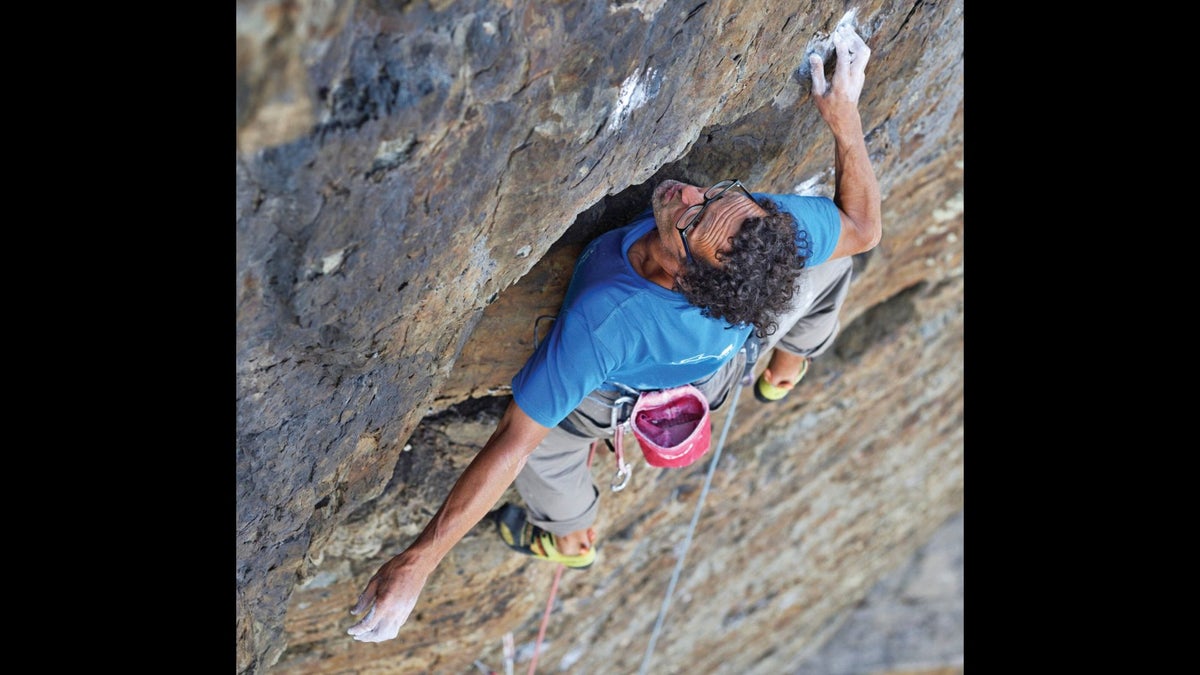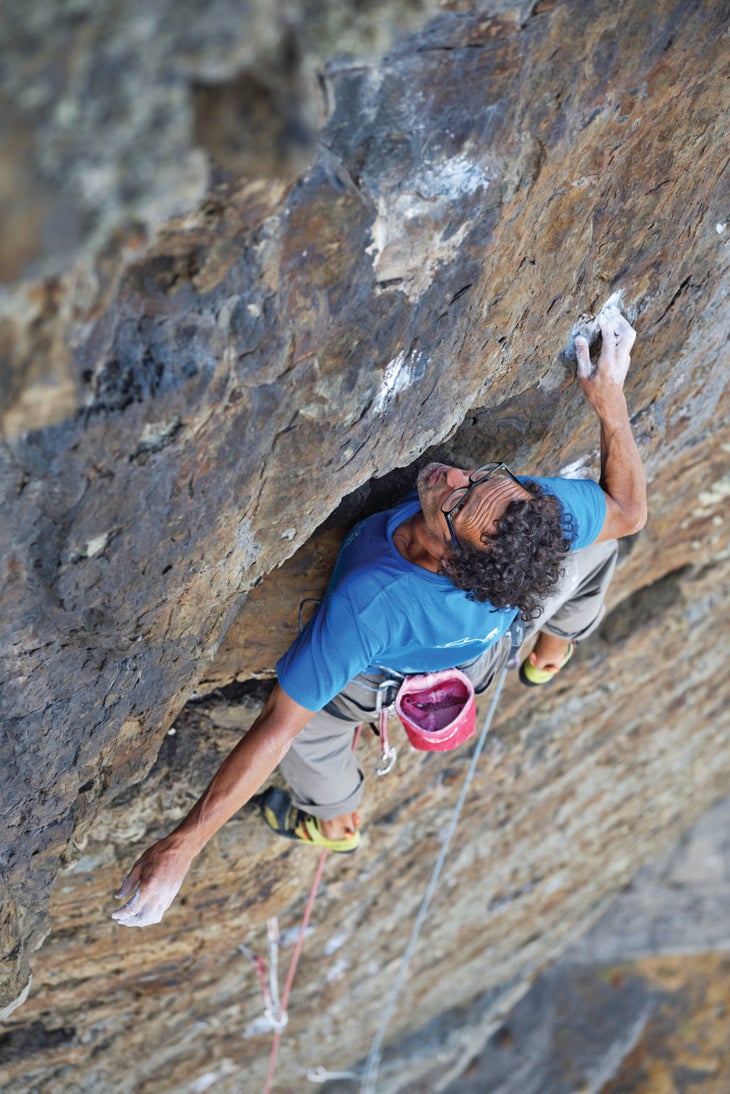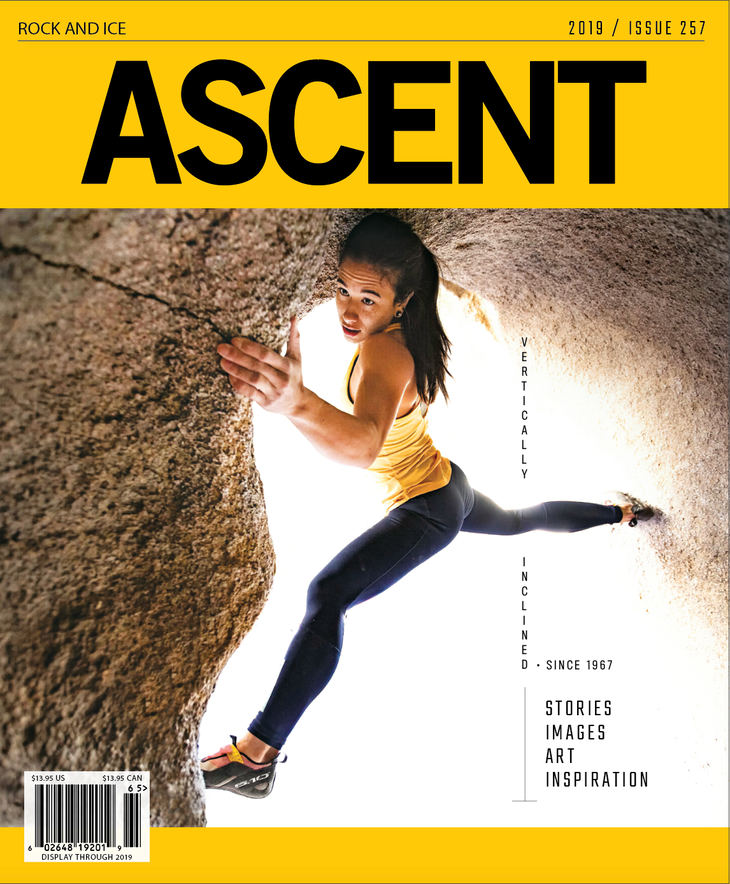Here’s a Bet: You’ve Never Been Sandbagged Quite Like This

Caff sat silently in the front seat, reflective. It could have been the thought of where we were heading, but I doubt that. Caff seldom appeared to worry about climbing. On the other hand, I should have been worried. But I had never climbed at Craig Dorys on the Llyn Peninsular, one of the most western points in Wales, so I chose not to worry, even though many of my friends had warned me.
It was 2004, North Wales. I was driving up around the Welsh coast after picking up James “Caff” McHaffie in Llanberis, a small town on the northern edge of Snowdonia National Park, that has certain things in abundance: rain, ravens, sheep, moss, ferns and seagulls, but most of all rock. Quartzite, slate, shale, limestone, mudstone, micro-granite, rhyolite and dolerite, with some of the best adventure climbing in the world. What Llanberis also has in abundance is people who rock climb, and many, like some of the rock, are a little loose.
Caff is son of the well-known climber Ray McHaffie from the Lake District in England. Ray McHaffie pioneered 250 routes in Borrowdale alone (he climbed many more in other areas of the Lakes), but he was possibly better known for climbing the classic Little Chamonix on Shepherd’s Crag in Borrowdale wearing boxing gloves and roller skates. When Ray died in 2005 at 69, his obituary in the Independent called that climb, which was done on a bet, “a stunt few would dare emulate on 230 feet of polished cliff at any grade.”
I only met Ray once, when he was in his 50s and waiting to have his hip replaced. He was soloing routes on Shepherd’s Crag and appeared to be enjoying himself though in pain.
“How you doing?” I asked.
“Hip slows me down, but I can still climb.”
We blathered on, and he asked if I knew his son James. I did. Ray swayed, and it could have been the pain, but I prefer to think it was in pride.
As Caff and I left the wet slate piled high above Llanberis, even the idea of dry shores and climbable rock felt illusory. But arriving at the coast to look out over the large water-worn boulders balancing on the tessellated rock shelf, to the expanse of sea and green emptiness, I knew the place was real. I didn’t realize yet quite how real.
Caff and I walked along the top of the cliff and down the steep track that sliced the grassy hill. Our feet crunched on small pieces of rock the winter wind had easily persuaded to leave the cliff. Like many crags in North Wales, Craig Dorys is tempered by the mark of humans. The detritus of farming—tangles of barbed wire and bailer twine—scattered the approach, but I didn’t find the rubbish offensive; it reminded me of the area I grew up in. I liked the juxtaposition of nature and the effect of humans on the landscape. “Perfect” didn’t sit with me or Dorys, and I’m sure it didn’t sit with Caff. I flicked a bleached sheep rib with the toe of my shoe.
I had climbed with Caff for two summers now, but not yet zoned in on what we here call the dark, possibly because Caff has a reserved demeanor and schoolboy appearance: small round glasses, unruly hair, pale skin, short stature. But to become one of the world’s most successful traditional rock climbers, repeatedly placing yourself in positions of danger while climbing in good style, takes dedication, mental fortitude, arrogance, drive, self-belief and, at times, darkness. I didn’t put myself in the same league as James McHaffie in rock climbing, but I recognized in him a castigating internal voice, telling him, at the very least, not to wimp out.
Caff pointed out the line. “Here you go, Nick, right up your street.”
Bobok would not be my recommendation for a first route on the Llyn Peninsular. It would not be a recommendation at all. Bobok is a short story by Dostoevsky, the title described in the Climbers Club guidebook to the Llyn as the chant of the dead people. I looked up at the gray overhanging wall, a semicircular gutter veined with orange, and it reminded me of mold creeping through cheese. Thin lines of glowing white quartz lit the way to an impending doom.

Caff dumped his bag in a pile of shale (presumably recently attached to the cliff), pulled a packet of tobacco from his jacket pocket, and rolled an incredibly thin cigarette. Dabbing the cigarette paper with his tongue, he looked up, eyeing the wall. He looked at me, and I laughed nervously.
“You’ll be fine, Nick. Bobok is only E5. Which pitch do you want?”
The route consisted of two pitches. The first was 70 feet and given a technical grade of 5c (5.10+/5.11). The second was 6a (5.11), more difficult but slightly shorter at 50 feet. The guidebook mentioned “chicken heads” and “sneaking” for the first pitch, with “quartz snappies” and “biscuit footholds” for the second. I was tempted to say I wanted neither, but I knew that wouldn’t work, so after much soul-searching I opted for the technically easier, but longer, first pitch. Sneaking, after all, was much more my style, and sounded preferable to snappies. Caff could handle those.
Stepping from the ground, crimping a vein of the orange mold, I had to try three times even to stand on the wall. Up, down, up, down, up, down …. The rock was like nothing I had climbed before, and the amount of gear clipped to my harness felt as heavy as an anchor. What looked like orange mold—bubbled, crozzled, crisp—was not mold-like at all, and it was the color and texture to aim for, although the thin shining strips of white had to be crimped on occasion. The least trustworthy color was gray—mudstone, bloody mudstone, moving like the pulp of a soft pear.
Caff had a pee, sat down, looked up, rolled his eyes, rolled another cigarette. “Just another 40 feet or so to go, Nick, you’re doing great. I reckon you’re higher than Leo Houlding was when he fell off and hit the ground.
Caff wallowed in the dirt as he belayed, drawing on his second tab. Puffs of smoke floated past my position at only about the height of a household ladder. Caff snickered, then guffawed, before placing the anorexic cigarette between tight lips and reading from the guidebook.
“Ray Kay says the chocolate-fudge color works well for taking weight.”
What Caff didn’t mention was that the Bobok first ascensionist, Ray Kay (a Llanberis resident in the 1980s, also known for having a dark side) was master of all things loose, and underwent many ground-up attempts to climb the line, finding the experience very, very scary. Caff also chose not to read me the paragraph written by Stevie Haston, who had attempted the climb before Kay and Dave Jones. In this omitted paragraph Haston had described becoming too scared to continue, lowering from five equalized pieces of gear and, from the ground, flicking all of them out.
I moved up again feeling like I had progressed a long way … but I hadn’t. Nausea washed across me. The sea, just over my right shoulder, sighed. I was too afraid to vomit because it would have meant holding on even tighter, so I climbed, placing more gear than ever before in such a short distance. The jangle of gear, the exasperation of the sea, Caff’s smoking; I heard it all. The rock below was now laced with multi-colored metal—stoppers slotted into a quartz skin, cams sunk into muddy cracks, hooks placed over thin white edges, slings wrapped around quartz protrusions—the illusion of safety, offering no safety at all. But with so much gear placed, I felt the pressure to continue. At around the two-hour mark, I had climbed 30 feet, maybe less.
Inching left, reaching the top of a decomposing pillar, I sat, terrified the whole column would collapse, and cautiously lowered a loop of rope to which Caff clipped a second rack of gear.
Sitting, delaying, I looked behind me and there, in front of my pale face, was a dark crack. I eyed the crack, seeping with muck and dirt, exuding a musty smell. I imagined stuffing it with gear, wrapping the rope around my waist like a Victorian climber and whispering, “On belay.”
“I’m sure this is the belay. It would make a great belay. Shall I belay from here?” I suggested.
Caff had a pee, sat down, looked up, rolled his eyes, rolled another cigarette. “Just another 40 feet or so to go, Nick, you’re doing great. I reckon you’re higher than Leo Houlding was before he fell off and hit the ground.”
I stood tentatively, clipping the second rack of gear to my harness. “What else are you not telling me about this climb?” I asked.
“If we climb it today, it will be the third ascent,” Caff replied.
This was quite telling given that it was an E5 climbed in 1988, 16 years earlier. “Who did the second ascent?”

“Will Perrin and Ben Bransby.”
I sat down again on my decomposing pillar contemplating that Perrin and Bransby were great rock climbers and very good at specialized territory, and I was neither.
How long would I need to procrastinate before Caff would get bored and offer to somehow drop a rope from above? How could I have been so stupid and naïve as to believe I could hold my own alongside Caff and Dorys? What an idiot. Sitting on my wobbly pillar, I made a pact with myself that should I survive this climb I would invest in my own pair of boxing gloves, just like Ray McHaffie’s, and pound his son with them.
The thought of biffing Caff around the ear spurred me on, yet I was only to be confronted by a roof. For the first time on the climb I was going to have to pull. This was not the sneaking promised by the guidebook. I felt betrayed, distraught and deflated, but three large cams placed within a few feet of each other got me swinging right, and with a mad-ditch dash (or, more realistically, a slow crawl), I reached the belay stance. I placed and clipped myself to seven pieces of gear, and happily called down: “Safe!” It had taken four hours and 40 pieces of gear. At last the dark surrounding me had lifted.
Caff joined me at my hanging stance in only minutes, which I attributed to him being on second, but then he proceeded to breeze the quartz snappies and biscuit footholds of the next pitch until, completely unfazed, he stood on top. I decided that the next time we came to Dorys, young Caff needed some kind of handicap … like a pair of roller skates.
Nick Bullock is a nomadic writer and climber. He enjoys reading Cormac McCarthy and poetry, and participating in all aspects of climbing: winter mixed, alpine, ice, rock and expedition.
This feature article was published under the title ‘Zoning in” in the 2019 edition of Ascent.

The post Here’s a Bet: You’ve Never Been Sandbagged Quite Like This appeared first on Climbing.

